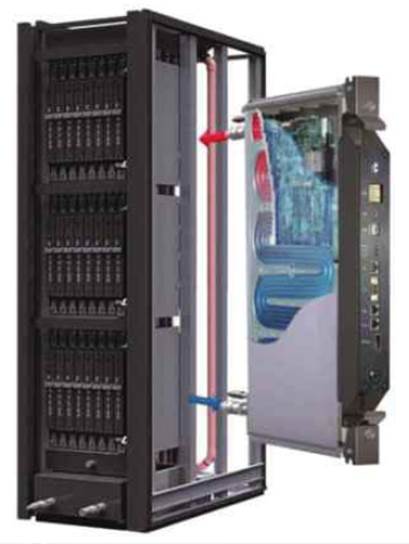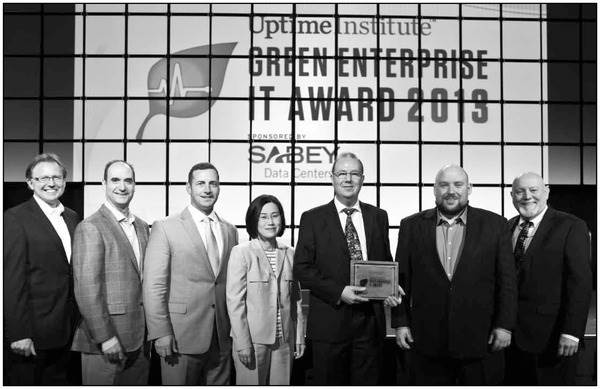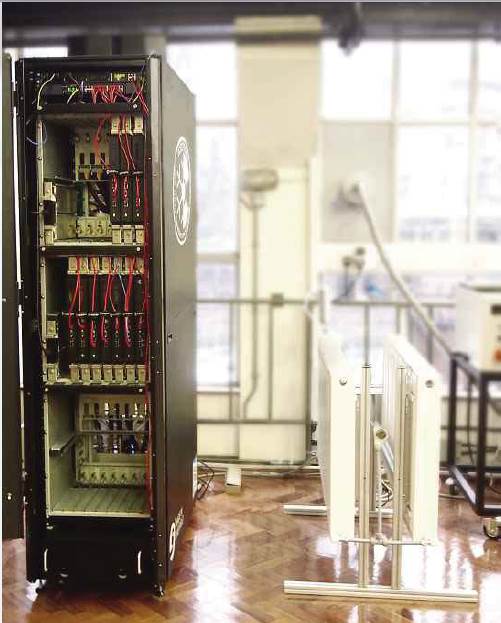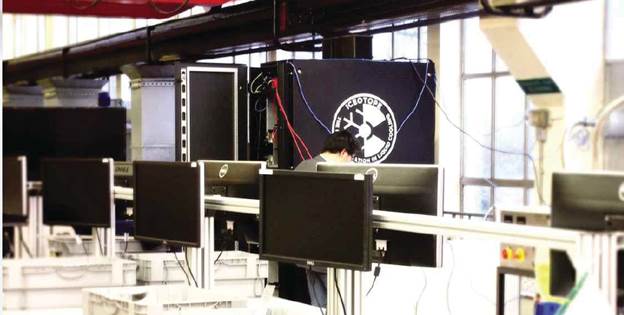We have a look at a new concept in server
cooking and chats to the designers
Cooling a significantly sized server room
is a challenge in itself. The energy requirements necessary to keep a constant air
temperature are quite extraordinary, making the server room a less than green
approach to providing adequate cooling. Then there are other aspects to take
into consideration, such as humidity control systems, air purification, air
conditioning servicing… the list goes on, and quite soon the server room itself
has become the single most expensive part of nay company’s IT equation.

The
Iceotope system uses server modules that can be easily fitted into the rack
However, the UK firm Iceotope has an
ingenious solution. Led by Dr. Jon Summers, from the University of Leeds’
School of Mechanical Engineering, a team of researcher has installed the first
production system of servers completely immersed in liquid.
Traditional air cooling has a number of
disadvantages when it comes to transferring heat away from a server. For
starters it’s very expensive, it’s noisy, it requires more energy and it’s not
particularly effective. Whereas liquid is server thousand times more effective
at transferring heat, it’s quieter in doing so and requires significantly less
energy.
The liquid in question is called 3M Novec,
a non-flammable coolant that doesn’t conduct electricity. In fact, it’s so
exceptional that said “The liquid we’re using is extraordinary stuff. You could
throw your mobile phone in a tub of it and the phone would work perfectly.”
The server and the liquid cooled system
uses a model based on computational fluid dynamics to represent the coolant as
it flows through the server, making it an ultra-efficient system, designed with
a simple low energy pump installed at the bottom of the cabinet, pumping a
secondary coolant, which is water, to the top, where it cascades down through
all 48 modules of the server thanks to gravity. The secondary coolant then
terminates at the heat exchangers within the cabinet for the transfer of heat
to a third and final coolant, on an external loop, taking the heat away for
external cooling or for reuse.
The high efficiency of this system means
that the output water can reach temperatures of up to 500C, which
can then be used for heating rooms and providing hot water. Overall, the
Iceotope-designed system uses a mere 80W of power to harvest the heat form up
to 20KW of ICT use.
It’s extraordinarily impressive, and
because there are no fans or air conditioning units, the server room is
considerably quieter and users and estimated 80 to 97% less energy to keep the
equipment at perfect operating temperature.
Interview with Iceotope
We took a moment from Iceotope’s busy
schedule to ask the team a few questions regarding this revolutionary liquid
cooled system:
Can
you tell us a bit more about the Iceotope Company? When did it start? What are
its objectives and goals?
Founded in 2011 with acquired IP dating
back to 2005, Sheffield- based star-up Iceotope has designed and engineered and
innovative liquid cooling system that solves some of the most pressing
challengers facing today’s data center operators. The technology has the
potential to halve the energy usage of the data center industry, prevent
millions of tons of CO2 being released into the atmosphere and reduce the
spiraling costs of running a data center facility. Iceotope ultimately aims to
offer 24/7 ‘free cooling’ anywhere in the world, including equatorial and
desert regions.

GEIT
Awards 2013
Was all the R&D work conducted here in
the UK, through and in conjunction with various universities?
Iceotope is the culmination of a five-year,
UK-based R&D effort. The company has worked in partnership with various
universities to include the University of Sheffield, Hallam and most recently
the University of Leeds. The current system is also backed by industry leaders
such as 3M and AMD.
How easy
would it be for a company to implement the Iceotope Liquid Cooling Server
solution into its own organization?
By negating the need for air handling,
chilling and humidity control equipment at the server, rack or building level,
the Iceotope Solution can be located almost anywhere with access to power and
water, including industrial space or populated areas. By negating fans from the
equation, the Iceotope solution is completely silent in operation, meaning that
servers can now be located in environments that were previously considered
unsuitable for data center use.
“The Iceotope concept may very well be the
saving grace and a positive outlook for a more green IT future”

The
Iceotope system transfers heat from the servers and can be used to heat up a
standar radiator.
How
do the setup costs of the Iceotope system compare with that of a traditional
machine room, air con setup?
By removing the need for specialized data
center design, the Iceotope Solution slashes CAPEX and OPEX in equal measure.
Traditional ‘air cooled’ data center facilities require extensive and expensive
infrastructure, sometimes resulting in 2/3 of the overall design. Such
facilities also require much more physical space for ventilation (hot and cold
aisles). The Iceotope Solution can be configured as a single supercomputer,
multiple server racks or scaled out to create entire data centers, offering new
builds and retrofits more building and more space for their money.
Would
there be any advantage to implementing this system at the desktop level? For
overclocking, perhaps?
Possibly, but our core market interest is
not desktops at the moment. Overclocking aims to keep desktop computers running
cool, whereas the Iceotope Solution aims to run server rooms neutral in terms
of heat thus allowing for optimal processing power. We might look at designing
a desktop product further down the line.
Which
companies have so far used this technology?
The first production system was installed
at the University of Leeds in January. We are in the process of installing a
second system in Poland, buyer to be announced and bidding for a third
requirement within the UK. We have a strong sales pipeline for 2013 and
into 2014.
What
happens if the systems fail? Is there a fan-based backup that kicks in?
There is no fan-based backup; the cooling
systems are fault tolerant and fully redundant. They can also tolerate prolonged
outages due to the thermal latency in the system.

The
Iceotope server racks in use at the University of Leeds.
Aside from reducing cooling cost by 97%,
what other ‘green’ benefits are there to be had from this system? Are the
materials used manufactured in a ‘green’ way, and can they themselves be
recycled?
In addition to reducing cooling costs by
97%, the Iceotope Solution reduces ICT power load by 20% and overall ICT
infrastructure cost by 50%. The technology can also help reduce associated CO2
emissions – something that the data center industry is going to have to address
soon, since it has been estimated to be on par with that of the airline
industry in the years to come.
The Iceotope Solution also delivers high-grade
heated exhaust water, which can be reused to heat buildings or for other
applications – another very valuable ‘green’ benefit that is unique to
Iceoptope.
Our patented products are designed ‘cradle
to cradle’ ensuring that all core components can be recovered and reused many
times and all of our products are also designed, engineered and manufactured
locally within the UK, and that’s something we are very proud of.
How
do you see the future of data center and server room cooling evolving? What projects
do you have in line for future Iceotope systems?
We believe that most data centers will be
liquid cooled in the future, the reason being that liquid is thousands of times
more effective at transferring heat than air, and the cooling aspect of such facilities
is the single largest contributor to inefficiency.
If you purchase a car today, the first
thing you think about is running costs (fuel efficiency). Although the data
center industry is enjoying double digit growth year on year, it’s suffering
from nay pain points that liquid cooling can solve, such as running costs
(cooling efficiency).
We’re finding in real customers that
flexibility and adaptability are key buying motives, funded by energy savings.
The fact that the Iceotope Solution does not even need a data center
environment, combined with the fact that it unifies servers and infrastructure
into a single simple yet elegant solution makes the choice for many to switch
from traditional air cooling to next-generation liquid cooling a simple and sensible
one.
Conclusion
The world of server room cooling is on the
verge of something very big. With the Iceotope system in effect, imagine the
global implications to the carbon footprint. The future is certainly looing
impressive, but there are still hurdles to overcome, chiefly the acceptance of
a new innovative system.
However, those involved are confident that
Iceotope’s system of cooling is the future; as Peter Hopton, Iceotope’s chief
technology officer and originator of the Iceotpe concept, said, “more than five
years of research, innovation and collaboration have gone into Iceotpe’s
technology. The basic principle of the design has many applications and, while
a few years, away, there is no reason why every home shouldn’t make better use
of the surplus heat form consumer electronics. Imagine having your PC or TV
plumbed into the central heating system”.

Peter
Hopton
In a world where the internet and cloud
services will grow to unimaginable proportions and data centers become the
equivalent of small towns in size, we as users have to take responsibility for
the impact our daily lives have on the environment, and the Iceotope concept
may very well be the saving grace and a positive outlook for a more green IT
future.
Key facts about data centers
·
The world’s data center use 31 gigawatts of power
– more than seven times the capacity of the UK’s largest coal-fired power
station, Drax in North Youkshire.
·
Data center carbon emissions are projected to quadruple
between 2008 and 2020.
·
The UK has 7.6 million square meters of data center
floor space.
·
One in three of the world’ population use data centers.
The number is growing at around 15% annually.
Further information
If you’re interested in the Iceotope system
and you want to find out more about the hardware and the concept behind it,
then take a look at the following pages:
·
www.iceotope.com
– the Iceotope home page.
·
Goo/gl/1no5V – Leeds University’s research news
·
goo.gl/9Q0qA- A video detailing the Iceotope system,
including the dunking of an iPhone into the liquid.
·
Googl/SpOsV – a collection of Iceotope demonstration
videos.